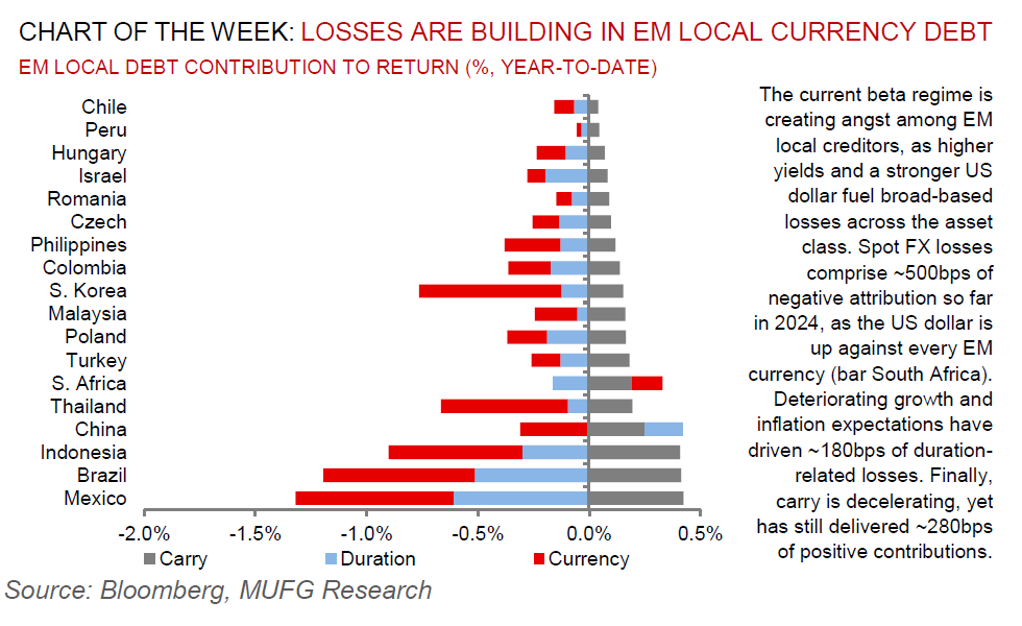To read the full report, please download the PDF above.
EM EMEA H1 2024 in review
EHSAN KHOMAN
Head of Commodities, ESG and
Emerging Markets Research –
EMEA
DIFC Branch – Dubai
T:+971 (4)387 5033
E: ehsan.khoman@ae.mufg.jp
SOOJIN KIM
Research Analyst
DIFC Branch – Dubai
T: +44(4)387 5031
E: soojin.kim@uk.mufg.jp
LEE HARDMAN
Senior Currency Analyst
Global Markets Research
Global Markets Division for EMEA
T: +44(0)20 577 1968
E: lee.hardman@uk.mufg.jp
MUFG Bank, Ltd.
A member of MUFG, a global financial group
Macro focus
As we approach the half way mark of 2024, we review the macro dimensions of how the EM EMEA region has fared. EM EMEA growth is proceeding slightly above potential, in line with the broader EM complex. Inflation has, by and large, been on a marked downward trajectory (bar Turkey, Russia and South Africa). Given this generalised easing in inflation, some EM EMEA central banks have cautiously begun to lower benchmark rates. In a global environment marked by an unfavourable growth-inflation mix, higher for longer rates, low liquidity and a strong US dollar, we continue to recommend macro stabilisation markets (Poland and Turkey) and structural growth narratives (GCC region) within the EM EMEA region. We also believe that investors are increasingly becoming comfortable with two frontier markets owing to idiosyncratic developments – Egypt (external financing relief and credit upgrades) and Nigeria (return to orthodox macro policies).
FX views
Over the past week EM currency performance has been more mixed, the RUB (+1.4% vs. USD) and ZAR (+1.2%) have continued to strengthen behind the best performing currency of the MXN (+2.4%) that has started to rebound following the sharp post-Mexican election sell-off. The USD has strengthened for three consecutive weeks even as US yields have been correcting lower. The 10-year US Treasury yield has been consolidating at just above the 4.20% over the past week after hitting a high of 4.74% in late April. The release in the week ahead of the latest US PCE deflator report for May is expected to provide further confirmation that core inflation has slowed in recent months.
Week in review
Poland's core inflation continues to nudge lower, down from 4.1% y/y in April to 3.8% y/y in May – lower than our (and consensus) forecasts of 3.9% y/y. South Africa’s inflation flatlined at 5.2% y/y in May matching our (and consensus) expectations. The National Bank of Hungary (MNB) lowered its base rate by 25bps to 7.00%, in line with our (and consensus) forecasts. Inflation in Dubai fell from 3.9% y/y in April to 3.8% y/y in May, whilst inflation in Saudi Arabia remained flat at 1.6% y/y in May – for the second consecutive month.
Week ahead
This week, we get rate decisions in Czech Republic (27 June) and Turkey (27 June) as well as preliminary inflation readings in Poland for June (28 June). In Turkey, we expect the CBRT to keep rates on hold at 50.00% (in line with consensus) and for the guidance to remain hawkish. In the Czech Republic, we expect the CNB to cut its policy rate by 25bp to 5.00% (in line with consensus). In Poland, we see headline inflation for June rising slightly (0.2ppts to 2.7% y/y).
Forecasts at a glance
Growth across the EM universe is set to stabilise as domestic fundamentals offset external drags, with some rotation from the largest to smaller EMs. Inflation and interest rates are both “over the hump” – disinflation is progressing, and the decline in rates will continue and broaden in 2024 (see here).
Core indicators
The latest weekly IIF flow data signalled that EM securities attracted USD0.4bn of inflows in the week ending 14 June – first inflows after three consecutive weekly outflows into the EM complex.


